What We’re Reading: December 1st
Review. Genomic selection in plant breeding: Methods, models, and perspectives
 In future years, climate change may cause significant economic losses to countries worldwide. Consequently, genetic improvement of crops fit for drought-stressed and semi-arid regions is becoming a must. In this review, Crossa et al. assess the advances in genetic selection (GS) and genomic-enabled prediction (GP) theory in comparison with the traditional phenotypic selection; and evaluate recent GP examples applied to cereal (maize and wheat, with data from the International Maize and Wheat Improvement Center) and legume (chickpea, with data from the International Crops Research Institute for the Semi-Arid Tropics) breeding programs. Crossa et al. conclude that developing GP models for gene bank accessions will be important to access unexplored diversity and fast-track useful options into breeding programs. (Summary by Isabel Mendoza) Trends Plant Sci. 10.1016/j.tplants.2017.08.011
In future years, climate change may cause significant economic losses to countries worldwide. Consequently, genetic improvement of crops fit for drought-stressed and semi-arid regions is becoming a must. In this review, Crossa et al. assess the advances in genetic selection (GS) and genomic-enabled prediction (GP) theory in comparison with the traditional phenotypic selection; and evaluate recent GP examples applied to cereal (maize and wheat, with data from the International Maize and Wheat Improvement Center) and legume (chickpea, with data from the International Crops Research Institute for the Semi-Arid Tropics) breeding programs. Crossa et al. conclude that developing GP models for gene bank accessions will be important to access unexplored diversity and fast-track useful options into breeding programs. (Summary by Isabel Mendoza) Trends Plant Sci. 10.1016/j.tplants.2017.08.011
Update: Advances in imaging plant cell dynamics
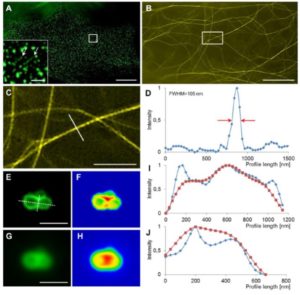 Since the days of Robert Hooke, microscopy has been one of the biologist’s most important tools, and continues to become ever more powerful. Komis et al. review recent advances in superresolution microscopy, particularly as they pertain to the dynamics of plant cells. Dynamic systems demand fast imaging, which can come at the expense of resolution. The authors discuss the applications and limitations key techniques including: structured illumination microscopy (SIM), photoactivation localization microscopy (PALM), stochastic optical reconstruction (STORM), stimulated emission depletion microscopy (STED), and light-sheet fluorescence microscopy (LSFM). (Summary by Mary Williams) Plant Physiol. 10.1104/pp.17.00962
Since the days of Robert Hooke, microscopy has been one of the biologist’s most important tools, and continues to become ever more powerful. Komis et al. review recent advances in superresolution microscopy, particularly as they pertain to the dynamics of plant cells. Dynamic systems demand fast imaging, which can come at the expense of resolution. The authors discuss the applications and limitations key techniques including: structured illumination microscopy (SIM), photoactivation localization microscopy (PALM), stochastic optical reconstruction (STORM), stimulated emission depletion microscopy (STED), and light-sheet fluorescence microscopy (LSFM). (Summary by Mary Williams) Plant Physiol. 10.1104/pp.17.00962
Review. Katanin: A sword that cuts microtubules for cellular, developmental, and physiological purposes
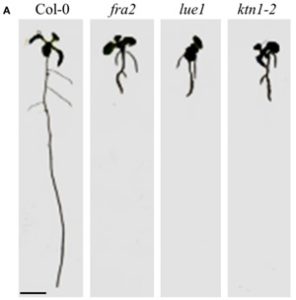 KATANIN is a AAA ATPase protein which, according to the most recent models, is able to track along microtubules (MTs) and sever emergent γ-TUBULIN and AUGMIN-nucleated MTs. This severing event occurs at MT cross-over areas, particularly where there are MT lattice defects, promoting disassembly of unfavorable MT orientation and mediating MT reorientation. Inducible overexpression of KATANIN results in heavy fragmentation of cortical MTs and favors MT bundling in Arabidopsis pavement cells. Many KATANIN mutants have been identified with diverse names. The first described mutant, bot1-1, had altered cortical MT organization and cell elongation leading to swollen cells and round, thick leaves and stems. Conversely, the fragile fiber 2 (fra2) mutant displayed widespread organ fragility and reduced cellulose deposition resulting in plants with pleiotropic phenotypes. A common feature of KATANIN mutants seems to be issues with fertility, as seen in both fra2 and ktn1-2 mutants which had siliques with unfertilized ovules and reduced seed set. Also, mutants typically have mitotic defects in which the spindle formation is unaltered but its positioning is deregulated, resulting in altered cell division plane orientation. Interestingly, KATANIN transcript accumulation can be induced by the hormones gibberellin, auxin, and ethylene while KATANIN itself can induce the expression of proteins important for modulating abiotic stress response. Learning more about KATANIN can help us comprehend how external stimuli result in molecular changes and coordination of cell growth in addition to adding to our knowledge of plant mitotic cell division. (Summary by Alecia Biel) Front Plant Sci. 10.3389/fpls.2017.01982.
KATANIN is a AAA ATPase protein which, according to the most recent models, is able to track along microtubules (MTs) and sever emergent γ-TUBULIN and AUGMIN-nucleated MTs. This severing event occurs at MT cross-over areas, particularly where there are MT lattice defects, promoting disassembly of unfavorable MT orientation and mediating MT reorientation. Inducible overexpression of KATANIN results in heavy fragmentation of cortical MTs and favors MT bundling in Arabidopsis pavement cells. Many KATANIN mutants have been identified with diverse names. The first described mutant, bot1-1, had altered cortical MT organization and cell elongation leading to swollen cells and round, thick leaves and stems. Conversely, the fragile fiber 2 (fra2) mutant displayed widespread organ fragility and reduced cellulose deposition resulting in plants with pleiotropic phenotypes. A common feature of KATANIN mutants seems to be issues with fertility, as seen in both fra2 and ktn1-2 mutants which had siliques with unfertilized ovules and reduced seed set. Also, mutants typically have mitotic defects in which the spindle formation is unaltered but its positioning is deregulated, resulting in altered cell division plane orientation. Interestingly, KATANIN transcript accumulation can be induced by the hormones gibberellin, auxin, and ethylene while KATANIN itself can induce the expression of proteins important for modulating abiotic stress response. Learning more about KATANIN can help us comprehend how external stimuli result in molecular changes and coordination of cell growth in addition to adding to our knowledge of plant mitotic cell division. (Summary by Alecia Biel) Front Plant Sci. 10.3389/fpls.2017.01982.
Review: Plasmodesmal regulation during plant- pathogen interactions
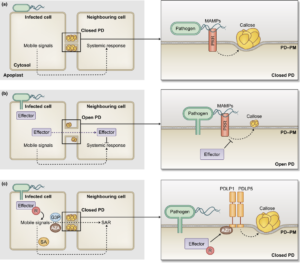 Plasmodesmata are plasma membrane-enclosed pores between cells that were initially described by Tangl in 1879 as ‘open communications’ between protoplasts of endosperm cells. These structures are regulated by callose deposition from the apoplast and play an important regulatory role in stress and developmental responses, although little is yet known about their role in modulating pathogen infection and defense responses. The regulation of plasmodesmata in host-microbe interactions is the topic of Tansley Insight by Cheval and Faulkner. The authors provide a comprehensive overview on the plasmodesmal regulation in innate immune responses and how they trigger systemic defense signaling. Regulation of plasmodesmata function by reactive oxygen species and defense associated small molecules in plant is described. The review also includes the pathogen perspective, describing how pathogens exploit plasmodesmata to promote colonization. Viruses use them for spreading from cell to cell, whereas several fungal pathogens have secreted effectors that either target these channels or use them for preparing the neighboring cells for infection. (Summary by Amey Redkar) New Phytol.
Plasmodesmata are plasma membrane-enclosed pores between cells that were initially described by Tangl in 1879 as ‘open communications’ between protoplasts of endosperm cells. These structures are regulated by callose deposition from the apoplast and play an important regulatory role in stress and developmental responses, although little is yet known about their role in modulating pathogen infection and defense responses. The regulation of plasmodesmata in host-microbe interactions is the topic of Tansley Insight by Cheval and Faulkner. The authors provide a comprehensive overview on the plasmodesmal regulation in innate immune responses and how they trigger systemic defense signaling. Regulation of plasmodesmata function by reactive oxygen species and defense associated small molecules in plant is described. The review also includes the pathogen perspective, describing how pathogens exploit plasmodesmata to promote colonization. Viruses use them for spreading from cell to cell, whereas several fungal pathogens have secreted effectors that either target these channels or use them for preparing the neighboring cells for infection. (Summary by Amey Redkar) New Phytol.
Perspectives: Plastics from plants, plastic recycling and plastic degradation
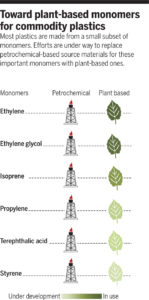 “If the current trend continues, there could be more plastic than fish by weight in the oceans by 2050” writes MacArthur in her Editorial, “Beyond plastic waste” (10.1126/science.aao6749). In three Perspective articles, challenges and opportunities to reduce plastic waste and improve its production are discussed. Hillmyer describes progress in developing plant-based plastics in “The promise of plastic from plants” (10.1126/science.aao6711). In “Designed to degrade,” Albertsson and Hakkarainen discuss the difficulties in designing degradable plastics including the fact that many plastics that degrade readily in compost (like shopping bags) do not break down in marine environments, contributing to the enormous environmental problem we are now facing (10.1126/science.aap8115). Finally, in “The future of plastics recycling,” Garcia and Robertson address why more than 90% of plastic waste in the US is not recycled, and explore new opportunities for improving plastic recycling 10.1126/science.aaq0324. (Summary by Mary Williams) Science.
“If the current trend continues, there could be more plastic than fish by weight in the oceans by 2050” writes MacArthur in her Editorial, “Beyond plastic waste” (10.1126/science.aao6749). In three Perspective articles, challenges and opportunities to reduce plastic waste and improve its production are discussed. Hillmyer describes progress in developing plant-based plastics in “The promise of plastic from plants” (10.1126/science.aao6711). In “Designed to degrade,” Albertsson and Hakkarainen discuss the difficulties in designing degradable plastics including the fact that many plastics that degrade readily in compost (like shopping bags) do not break down in marine environments, contributing to the enormous environmental problem we are now facing (10.1126/science.aap8115). Finally, in “The future of plastics recycling,” Garcia and Robertson address why more than 90% of plastic waste in the US is not recycled, and explore new opportunities for improving plastic recycling 10.1126/science.aaq0324. (Summary by Mary Williams) Science.
Whole-genome sequencing reveals the extent of GC-biased gene conversion in plants and fungi ($)
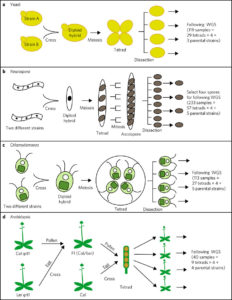 Gene conversion, a mechanism involving the unidirectional exchange of DNA from a donor to an acceptor sequence through homologous recombination, is a major driver of genome evolution. It has been speculated that gene conversion may be biased towards GC alleles, and thus favours accumulation of GC in the genome. Nevertheless, this hypothesis has never been tested at the intra- and inter-species levels using state-of-the-art sequencing methodologies. In tetrad analysis, the four products of meiosis remain physically associated, enabling crossovers to be precisely mapped. In this article, Liu et al. provide a uniform whole-genome sequencing of tetrads isolated from two fungal species (Saccharomyces and Neurospora) and two plant species (Chlamydomonas and Arabidopsis). The data reveal that the gene conversion rate varies largely between the species tested; with the plant species displaying the lowest rates of conversion. Moreover, comparison between local GC content and recombination rate reveals no global GC bias in this phenomenon. This study provides new insights on the impact of gene conversion on genome evolution and offers new perspectives for researchers in population genetics. (Summary by Matthias Benoit) Nature Ecol. Evol. 10.1038/s41559-017-0372-7.
Gene conversion, a mechanism involving the unidirectional exchange of DNA from a donor to an acceptor sequence through homologous recombination, is a major driver of genome evolution. It has been speculated that gene conversion may be biased towards GC alleles, and thus favours accumulation of GC in the genome. Nevertheless, this hypothesis has never been tested at the intra- and inter-species levels using state-of-the-art sequencing methodologies. In tetrad analysis, the four products of meiosis remain physically associated, enabling crossovers to be precisely mapped. In this article, Liu et al. provide a uniform whole-genome sequencing of tetrads isolated from two fungal species (Saccharomyces and Neurospora) and two plant species (Chlamydomonas and Arabidopsis). The data reveal that the gene conversion rate varies largely between the species tested; with the plant species displaying the lowest rates of conversion. Moreover, comparison between local GC content and recombination rate reveals no global GC bias in this phenomenon. This study provides new insights on the impact of gene conversion on genome evolution and offers new perspectives for researchers in population genetics. (Summary by Matthias Benoit) Nature Ecol. Evol. 10.1038/s41559-017-0372-7.
Increased efficiency of targeted mutagenesis by CRISPR/Cas9 in plants using heat stress ($)
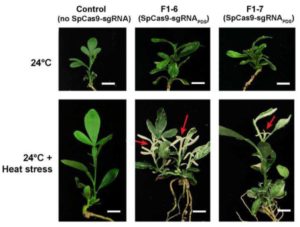 CRISPR/Cas9 genome editing has rapidly become a powerful tool in modern plant science research. However, issues of low editing efficiencies and off-target mutations remain. LeBlanc et al. hypothesised that subjecting plants to high temperature stress, mimicking the optimal operating temperature of Streptococcus pyogenes Cas9, would increase editing efficiency. When Arabidopsis plants expressing a GFP reporter, Cas9, and a sgRNA targeting the reporter were subjected to heat treatments, editing efficiency was drastically enhanced. Off-target editing also increased, although ensuring the sgRNA seed region was specific to the target (at least two base pairs different to other genomic sites) avoided this side-effect. Improved editing efficiency resulted from enhanced Cas9 activity and sgRNA levels. (Summary by Mike Page) Plant J. 10.1111/tpj.13782
CRISPR/Cas9 genome editing has rapidly become a powerful tool in modern plant science research. However, issues of low editing efficiencies and off-target mutations remain. LeBlanc et al. hypothesised that subjecting plants to high temperature stress, mimicking the optimal operating temperature of Streptococcus pyogenes Cas9, would increase editing efficiency. When Arabidopsis plants expressing a GFP reporter, Cas9, and a sgRNA targeting the reporter were subjected to heat treatments, editing efficiency was drastically enhanced. Off-target editing also increased, although ensuring the sgRNA seed region was specific to the target (at least two base pairs different to other genomic sites) avoided this side-effect. Improved editing efficiency resulted from enhanced Cas9 activity and sgRNA levels. (Summary by Mike Page) Plant J. 10.1111/tpj.13782
Development of gene expression system in egg cells and zygotes isolated from rice and maize
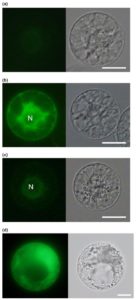 Assessing the function of genes active in zygotes and egg cells is difficult due to the inaccessibility of the target tissues. Koiso et al. isolated rice egg cells and maize zygotes using a method similar to that for extracting leaf protoplasts. They then optimized a PEG-Ca2+ transfection protocol to introduce plasmid DNA for transient expression in the isolated cells. The transfection efficiency and transgene expression level were sufficient to assess subcellular localization of the proteins encoded on the plasmid. In addition, some of the maize zygotes were successfully regenerated into plantlets, although none demonstrated integration of the transgene into genomic DNA. However, the authors observe that this method could be employed for transient expression of CRISPR/Cas9 genome editing system. (Summary by Mike Page) Plant Direct 10.1002/pld3.10
Assessing the function of genes active in zygotes and egg cells is difficult due to the inaccessibility of the target tissues. Koiso et al. isolated rice egg cells and maize zygotes using a method similar to that for extracting leaf protoplasts. They then optimized a PEG-Ca2+ transfection protocol to introduce plasmid DNA for transient expression in the isolated cells. The transfection efficiency and transgene expression level were sufficient to assess subcellular localization of the proteins encoded on the plasmid. In addition, some of the maize zygotes were successfully regenerated into plantlets, although none demonstrated integration of the transgene into genomic DNA. However, the authors observe that this method could be employed for transient expression of CRISPR/Cas9 genome editing system. (Summary by Mike Page) Plant Direct 10.1002/pld3.10
Pollen magnetofection for genetic modification with magnetic nanoparticles as gene carriers
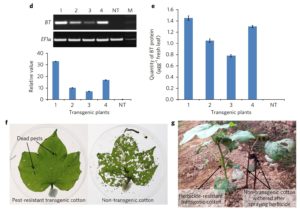 The ability to generate transgenic plants has revolutionised plant science research. However, many species and genotypes remain challenging and time-consuming to transform. Zhao et al. provide a novel and potentially ground-breaking method of transgene delivery. In the presence of a magnetic field, iron oxide nanoparticles coated with plasmid DNA entered pollen grains through apertures in the pollen wall. Artificial pollination with ‘magnetofected’ pollen yielded transgenic seed, with the transgene stably integrating into the host genome. Using this method, the authors generated transgenic cotton plants expressing the insecticidal Bt toxin, as-well-as transgenic pumpkin (Cucurbita moschata) and pepper (Cucurbita pepo L.) plants, marking a breakthrough for these recalcitrant species. (Summary by Mike Page) Nature Plants 10.1038/s41477-017-0063-z
The ability to generate transgenic plants has revolutionised plant science research. However, many species and genotypes remain challenging and time-consuming to transform. Zhao et al. provide a novel and potentially ground-breaking method of transgene delivery. In the presence of a magnetic field, iron oxide nanoparticles coated with plasmid DNA entered pollen grains through apertures in the pollen wall. Artificial pollination with ‘magnetofected’ pollen yielded transgenic seed, with the transgene stably integrating into the host genome. Using this method, the authors generated transgenic cotton plants expressing the insecticidal Bt toxin, as-well-as transgenic pumpkin (Cucurbita moschata) and pepper (Cucurbita pepo L.) plants, marking a breakthrough for these recalcitrant species. (Summary by Mike Page) Nature Plants 10.1038/s41477-017-0063-z
MAPKs influence pollen-tube growth via phosphorylation of PIP5K6, affecting PtdIns(4,5)P2 formation
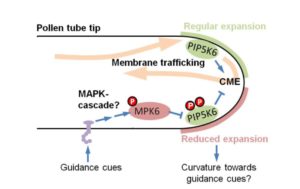 Pollen tubes exhibit unidirectional, polar growth because vesicles carrying compounds required for growth are selectively transported to the growing apex. The phosphoinositide PtdIns(4,5)P2 accumulates at the apex and is thought to help with vesicle targeting. Helpel et al. showed that the lipid kinase responsible for PtdIns(4,5)P2 production, PIP5K6, is phosphorylated by incubation with extracts from elongating pollen tubes. They identified MPK6 as a protein kinase that interacts with and phosphorylates PIP5K6, inhibiting its activity and interfering with PtdIns(4,5)P2 production and pollen tube elongation. The authors suggest that regulation of PtdIns(4,5)P2 production via MAPKs may help to control the directional growth of pollen tubes. (Summary by Mary Williams) Plant Cell 10.1105/tpc.17.00543
Pollen tubes exhibit unidirectional, polar growth because vesicles carrying compounds required for growth are selectively transported to the growing apex. The phosphoinositide PtdIns(4,5)P2 accumulates at the apex and is thought to help with vesicle targeting. Helpel et al. showed that the lipid kinase responsible for PtdIns(4,5)P2 production, PIP5K6, is phosphorylated by incubation with extracts from elongating pollen tubes. They identified MPK6 as a protein kinase that interacts with and phosphorylates PIP5K6, inhibiting its activity and interfering with PtdIns(4,5)P2 production and pollen tube elongation. The authors suggest that regulation of PtdIns(4,5)P2 production via MAPKs may help to control the directional growth of pollen tubes. (Summary by Mary Williams) Plant Cell 10.1105/tpc.17.00543
A bacterial effector targets the master immune regulator NPR1 ($)
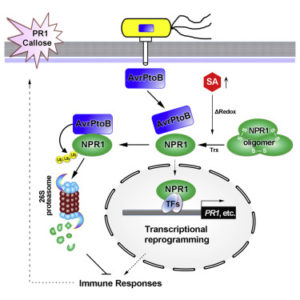 Pathogenic microbes translocate effector molecules into plant cells that subvert host immune responses and promote disease. In a recent article published in Cell Host & Microbe, Chen et al. (2017) describe an exciting new interaction between the Pseudomonas syringae effector AvrPtoB and its cognate host target: the master immune regulator NPR1. Intriguingly, the authors show that the plant defense hormone salicylic acid (SA) promotes the AvrPtoB-NPR1 interaction, which subsequently leads to the poly-ubiquitination and proteasomal degradation of NPR1. This effectively suppresses NPR1’s function in SA signalling, ultimately leading to enhanced microbial growth in the now immunocompromised host plant. (Summary by Philip Carella) Cell Host Microb. 10.1016/j.chom.2017.10.019
Pathogenic microbes translocate effector molecules into plant cells that subvert host immune responses and promote disease. In a recent article published in Cell Host & Microbe, Chen et al. (2017) describe an exciting new interaction between the Pseudomonas syringae effector AvrPtoB and its cognate host target: the master immune regulator NPR1. Intriguingly, the authors show that the plant defense hormone salicylic acid (SA) promotes the AvrPtoB-NPR1 interaction, which subsequently leads to the poly-ubiquitination and proteasomal degradation of NPR1. This effectively suppresses NPR1’s function in SA signalling, ultimately leading to enhanced microbial growth in the now immunocompromised host plant. (Summary by Philip Carella) Cell Host Microb. 10.1016/j.chom.2017.10.019
An Arabidopsis glycine-rich plasma membrane protein enhances disease resistance in soybean
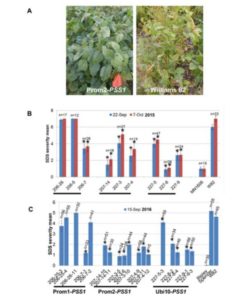 Previously, the authors identified an Arabidopsis mutant that shows resistance to a widespread oomycete pathogen. In this new work, Wang et al. identified the Phytophthora sojae susceptible gene locus, PSS1, which encodes a plasma-membrane localized glycine-rich protein. When introduced into soybean plants, PSS1 confers enhanced resistance to the fungal pathogen Fusarium virguliforme, causal agent of soybean sudden death syndrome. As the authors observe, more than 80% of soybeans cultivated worldwide are already transgenic, so implementing this resistance trait should be straightforward. (Summary by Mary Williams) Plant Physiol. 10.1104/pp.16.01982
Previously, the authors identified an Arabidopsis mutant that shows resistance to a widespread oomycete pathogen. In this new work, Wang et al. identified the Phytophthora sojae susceptible gene locus, PSS1, which encodes a plasma-membrane localized glycine-rich protein. When introduced into soybean plants, PSS1 confers enhanced resistance to the fungal pathogen Fusarium virguliforme, causal agent of soybean sudden death syndrome. As the authors observe, more than 80% of soybeans cultivated worldwide are already transgenic, so implementing this resistance trait should be straightforward. (Summary by Mary Williams) Plant Physiol. 10.1104/pp.16.01982
ANXUR receptor-like kinases contribute to both PRR- and NLR-mediated immunity ($)
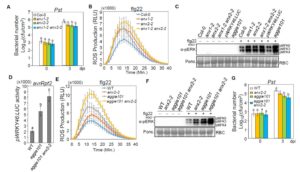 The plant immune system is often described as having two parts, one which recognizes extracellular conserved microbial signals (pattern-triggered immunity: PTI) and one which is stimulated by the presence of specific microbial effectors (effector-triggered immunity: ETI). Through a forward-genetic screen, Mang et al. identified a pair of receptor-like kinases ANX1 and ANX2 that are negative regulators for both branches of the immune pathway. In addition to the genetic studies, the authors showed that ANX1 complexes with both FLS2/BAK2 (mediators of PTI) and RPS2/RPM1 (mediators of ETI1). (Summary by Mary Williams) Plant Cell 10.1105/tpc.17.00464
The plant immune system is often described as having two parts, one which recognizes extracellular conserved microbial signals (pattern-triggered immunity: PTI) and one which is stimulated by the presence of specific microbial effectors (effector-triggered immunity: ETI). Through a forward-genetic screen, Mang et al. identified a pair of receptor-like kinases ANX1 and ANX2 that are negative regulators for both branches of the immune pathway. In addition to the genetic studies, the authors showed that ANX1 complexes with both FLS2/BAK2 (mediators of PTI) and RPS2/RPM1 (mediators of ETI1). (Summary by Mary Williams) Plant Cell 10.1105/tpc.17.00464
The Medicago truncatula GRAS protein RAD1 supports arbuscular mycorrhiza symbiosis and Phytophthora palmivora susceptibility
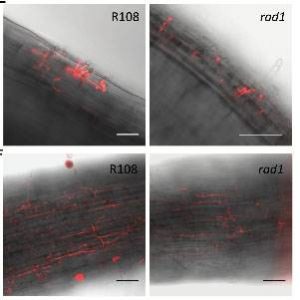 Within the same species, plant responses to pathogens vary depending on the plant genotype. The correlation between phenotypic and genetic variation is a great resource for finding genes involved in plant-pathogen interactions. By using a set of natural accessions of Medicago truncatula (HapMap population) and by quantifying their susceptibility to an oomycete (Phytophtora palmivora), Rey and colleagues were able to identify a GRAS transcription factor regulating oomycete abundance in the root tissues. Interestingly, the gene identified through the genome wide association study, RAD1, was previously shown to be necessary for the establishment of legume symbiosis with Rhizobia and with arbuscular mycorrhizal fungi. The authors, therefore, show that an overlapping genetic program is mediating root responses both to symbionts and pathogens. (Summary by Marco Giovanetti) J. Exp. Bot. 10.1093/jxb/erx398
Within the same species, plant responses to pathogens vary depending on the plant genotype. The correlation between phenotypic and genetic variation is a great resource for finding genes involved in plant-pathogen interactions. By using a set of natural accessions of Medicago truncatula (HapMap population) and by quantifying their susceptibility to an oomycete (Phytophtora palmivora), Rey and colleagues were able to identify a GRAS transcription factor regulating oomycete abundance in the root tissues. Interestingly, the gene identified through the genome wide association study, RAD1, was previously shown to be necessary for the establishment of legume symbiosis with Rhizobia and with arbuscular mycorrhizal fungi. The authors, therefore, show that an overlapping genetic program is mediating root responses both to symbionts and pathogens. (Summary by Marco Giovanetti) J. Exp. Bot. 10.1093/jxb/erx398
Plant-to-plant communication triggered by systemin primes anti-herbivore resistance in tomato
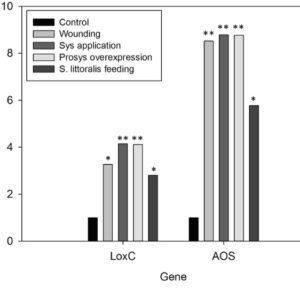 Plant-to-plant communication allows plant neighbors to be warned by plant peers of stresses such as herbivory activity, sometimes by triggering priming processes. Systemin is an 18-amino acid hormone, firstly identified in tomato as a inducer of the wound response. Coppola et al. report the role of systemin application/overexpression in communication between source tomaro plants (S) and receiver (R) tomato plants. The authors demonstrate that systemin can trigger gene expression (LoxC and AOS) and metabolic changes even in neighboring unchallenged plants, including increased resistance to phytophagous larvae (Spodoptera littoralis). The paper advocates for the possible use of systemin in the development of pest control strategies for tomato cultivation. (Summary by Isabel Mendoza) Sci. Reports. 10.1038/s41598-017-15481-8
Plant-to-plant communication allows plant neighbors to be warned by plant peers of stresses such as herbivory activity, sometimes by triggering priming processes. Systemin is an 18-amino acid hormone, firstly identified in tomato as a inducer of the wound response. Coppola et al. report the role of systemin application/overexpression in communication between source tomaro plants (S) and receiver (R) tomato plants. The authors demonstrate that systemin can trigger gene expression (LoxC and AOS) and metabolic changes even in neighboring unchallenged plants, including increased resistance to phytophagous larvae (Spodoptera littoralis). The paper advocates for the possible use of systemin in the development of pest control strategies for tomato cultivation. (Summary by Isabel Mendoza) Sci. Reports. 10.1038/s41598-017-15481-8
A nanobionic light emitting plant ($)
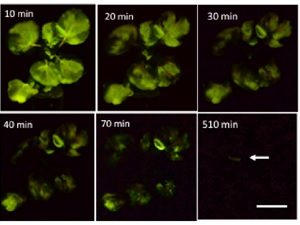 Reading books by the light of nanobionic plants sounds like something out of a scifi book. However, scientists have been working for many years on engineering light-emitting plants based on the luciferase enzyme. This work has been limited largely by the need to overcome the toxicity of adding to much luciferin (the substrate for luciferase), co-localizing the reactive enzymes, and supplying enough ATP to power the chemical reactions. Kwak et al. attempt to tackle these problems utilizing several variants of common plants (spinach, kale, watercress, and arugula). These plants have empirically high ATP production rates, which may help to power these chemical reactions. The authors introduced a mixture of four chemically-interacting nanoparticles, from firefly luciferase conjugates to semiconductor nanocrystal phosphors, to living plants through stomatal pores using a pressurized bath infusion system. By this method, they were able to induce a visible light source in non-transgenic leaves. The nanoparticles are designed with specific size and surface charges in order to target specific compartments (leaf mesophyll cells and guard cells shown here) and also to help combat the toxicity of luciferin. Through addition of chemical activators and inhibitors, the light source can also be turned “on” or “off”. Although this work is still far off from each of us reading by the light of a plant, it is the first time plants have been successfully used as self-powered light sources using only nanotechnological approaches. Nano Letters. (Summary by Alecia Biel) 10.1021/acs.nanolett.7b04369.
Reading books by the light of nanobionic plants sounds like something out of a scifi book. However, scientists have been working for many years on engineering light-emitting plants based on the luciferase enzyme. This work has been limited largely by the need to overcome the toxicity of adding to much luciferin (the substrate for luciferase), co-localizing the reactive enzymes, and supplying enough ATP to power the chemical reactions. Kwak et al. attempt to tackle these problems utilizing several variants of common plants (spinach, kale, watercress, and arugula). These plants have empirically high ATP production rates, which may help to power these chemical reactions. The authors introduced a mixture of four chemically-interacting nanoparticles, from firefly luciferase conjugates to semiconductor nanocrystal phosphors, to living plants through stomatal pores using a pressurized bath infusion system. By this method, they were able to induce a visible light source in non-transgenic leaves. The nanoparticles are designed with specific size and surface charges in order to target specific compartments (leaf mesophyll cells and guard cells shown here) and also to help combat the toxicity of luciferin. Through addition of chemical activators and inhibitors, the light source can also be turned “on” or “off”. Although this work is still far off from each of us reading by the light of a plant, it is the first time plants have been successfully used as self-powered light sources using only nanotechnological approaches. Nano Letters. (Summary by Alecia Biel) 10.1021/acs.nanolett.7b04369.



